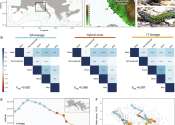Embryonic cells sense stiffness in order to form the face
Cells in the developing embryo can sense the stiffness of other cells around them, which is key to them moving together to form the face and skull, finds a new study by UCL researchers.

Cells in the developing embryo can sense the stiffness of other cells around them, which is key to them moving together to form the face and skull, finds a new study by UCL researchers.
Molecular & Computational biology
Dec 8, 2021
0
478

The hypothalamus is involved during the coordination of neuroendocrine functions in vertebrates and their evolutionary origin can be described using integrated transcriptome or connectome brain maps of swimming tadpoles of ...

Lamprey are blood-sucking vampire-like fish that attach to and eventually kill game fish, making them the bane of many a fisherman's existence. Like something out of a horror film, these parasites use radial rows of sharp ...
Plants & Animals
Nov 19, 2019
0
355

The embryonic stem cells that form facial features, called neural crest cells, use an unexpected mechanism of moving from the back of the head to the front to populate the face, finds a new UCL-led study.
Cell & Microbiology
Oct 18, 2018
0
70

In biology, one long-running debate has teeth: whether ancient fish scales moved into the mouth with the origin of jaws, or if the tooth had its own evolutionary inception.
Archaeology
Nov 20, 2017
0
198

The vivid pigmentation of zebras, the massive jaws of sharks, the fight or flight instinct and the diverse beaks of Darwin's finches. These and other remarkable features of the world's vertebrates stem from a small group ...
Cell & Microbiology
Apr 30, 2015
0
1388

Body shape, color and behavior often evolve together as species adapt to their environment. Researchers from Lund University in Sweden have studied this phenomenon in a specific type of large, bright green and aggressive ...
Plants & Animals
Apr 29, 2024
0
7

Physical cues in the womb, and not just genetics, influence the normal development of neural crest cells, the embryonic stem cells that form facial features, finds a new study led by UCL researchers.
Cell & Microbiology
Apr 22, 2024
0
42

An international scientific team including more than 40 authors from seven different countries, led by a researcher at the University of Malaga Juan Pascual Anaya, has managed to sequence the first genome of the myxini, also ...
Evolution
Jan 12, 2024
0
273

A new discovery by researchers challenges our current understanding of gastrulation, the most important stage of early embryonic development.
Cell & Microbiology
Sep 27, 2023
0
0